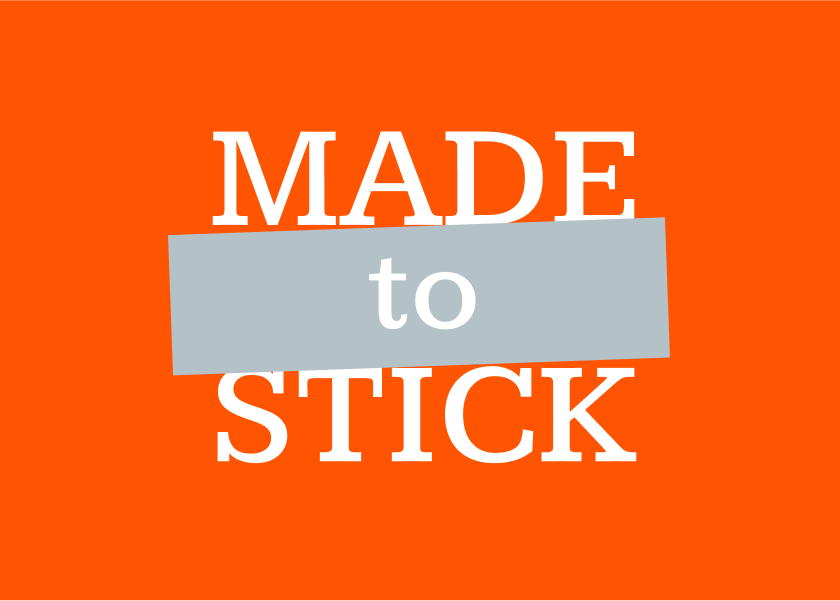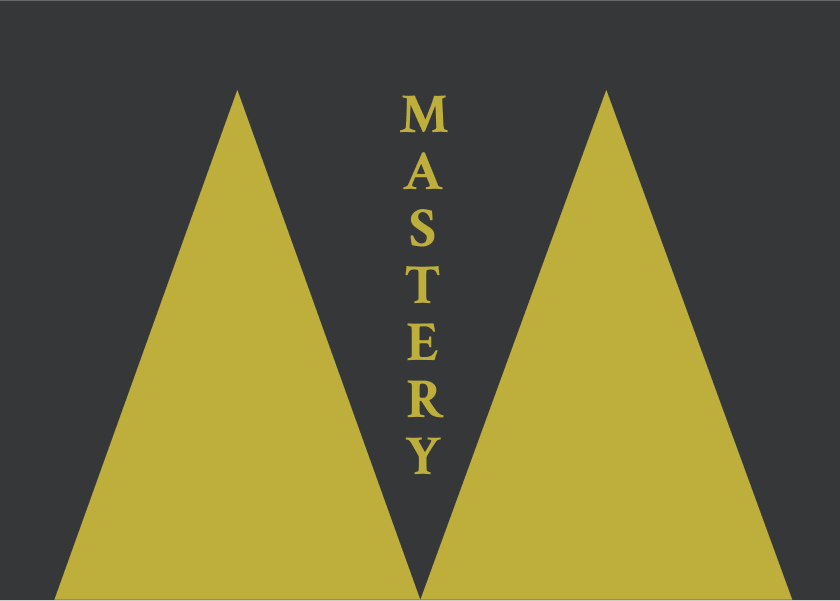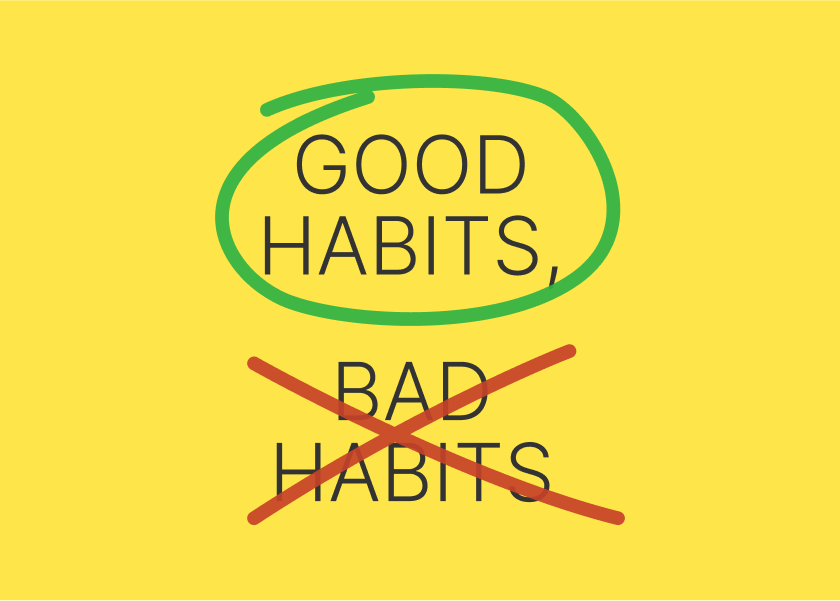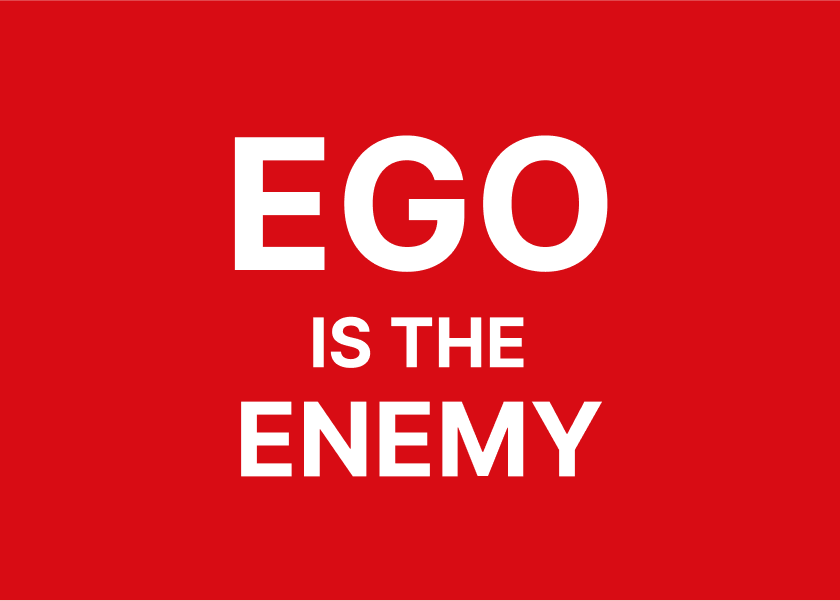Made to Stick by Chip and Dan Heath - Summary
Want your ideas to stick? Learn the 6 principles (SUCCESs) behind unforgettable messages, from urban legends to JFK's moonshot. Make your communication powerful!

The following is a summary and review of the book Made to Stick by Chip and Dan Heath.
Listen to ShelfHelp's podcast summarising Made to Stick by Chip and Dan Heath.
Why Some Ideas Survive and Others Die
Do you ever feel like your brilliant ideas vanish the moment they leave your lips? Have you struggled to make your message resonate, whether it's in a boardroom, a classroom, or even just chatting with friends? Chip Heath and Dan Heath’s insightful book, Made to Stick: Why Some Ideas Survive and Others Die, delves into this very problem, unravelling the mysteries behind why some ideas capture our attention, stick in our memories, and ultimately change our thoughts or behaviours, while others fade into oblivion.
This popular book, written by a Stanford professor of organisational behaviour and a consultant in corporate education, offers a practical and engaging framework – the SUCCESs principles – to help anyone craft more impactful and memorable messages. If you're looking to save time and gain actionable tips on how to make your ideas truly take hold, this summary offers a comprehensive overview of the book's key concepts.
Table of Contents
- About the Author
- Who Should Read This Book?
- Key Insights and Themes
- Detailed Summary
- Review
- Actionable Takeaways
- FAQs
- Conclusion
About the Author
Chip Heath is a professor of organisational behaviour at the Graduate School of Business at Stanford University. His research has focused on why bad ideas sometimes triumph in the social marketplace and what makes some ideas more viral than others. Dan Heath is a consultant at Duke Corporate Education and the co-founder of Thinkwell, a start-up publishing company focused on innovative textbook creation using video and technology. His experience as editor-in-chief of Thinkwell provided him with a deep understanding of effective teaching methodologies. Together, their diverse expertise in academia and practical communication strategies makes them highly credible guides in understanding and applying the principles of sticky ideas.
Who Should Read This Book?
Made to Stick is an invaluable resource for anyone who needs to communicate effectively and persuasively. This includes, but is not limited to:
- Teachers and Educators: Struggling to make lessons memorable and ensure students grasp core concepts.
- Managers and Leaders: Aiming to communicate strategic visions, motivate teams, and ensure understanding of key objectives.
- Marketers and Advertisers: Seeking to create campaigns that capture attention, are remembered, and drive action.
- Public Speakers and Presenters: Wanting to deliver talks that resonate with their audience and leave a lasting impact.
- Anyone with Ideas to Share: From public health officials trying to raise awareness to individuals simply wanting their opinions to be heard and remembered.
If you've ever felt that your message hasn't landed or that your important points have been overlooked, this book provides the tools and insights to transform your communication approach.
Key Insights and Themes
The book revolves around the SUCCESs framework, which outlines six key principles of sticky ideas:
- Simple: Finding the core of your idea and expressing it concisely and profoundly, like a proverb.
- Unexpected: Grabbing people's attention by violating their expectations and then maintaining their interest by creating curiosity.
- Concrete: Making your ideas tangible and easy to visualise, using sensory details rather than abstract concepts.
- Credible: Ensuring your audience believes your message, whether through external authorities, anti-authorities, vivid details, statistics used effectively, or by passing the "Sinatra Test" (demonstrating your claim through an example).
- Emotional: Making people care about your idea by tapping into their feelings and focusing on the individual rather than abstract masses.
- Stories: Using narratives to provide simulation (knowledge of how to act) and inspiration (motivation to act).
The authors also highlight the Curse of Knowledge as a significant obstacle to creating sticky ideas. This is the tendency for those who know a lot about a topic to struggle to communicate with those who don't, as they forget what it's like not to have that knowledge. The book argues that by consciously applying the SUCCESs principles, we can overcome the Curse of Knowledge and make our ideas more likely to stick.
Detailed Summary
Introduction: What Sticks?
The book opens by contrasting the memorable urban legend of the "Kidney Heist" with a dense, forgettable passage from a non-profit organisation's paper. The "Kidney Heist" story sticks because it is understandable, memorable, and effective in changing behaviour. The authors pose the central question: can worthwhile ideas be made to circulate as effectively as false, but "naturally sticky," ideas?. They argue that stickiness isn't inherent but can be nurtured by understanding why certain ideas succeed. They introduce the SUCCESs framework as the key to making ideas stick – meaning they are understood, remembered, and have a lasting impact.
Chapter 1: Simple
Simplicity isn't about dumbing down; it's about finding the core of your idea and expressing it in a compact way. Like the military concept of Commander's Intent, a simple idea focuses on the most important goal. Examples include Southwest Airlines' core identity as "THE low-fare airline" and the power of proverbs like the Golden Rule ("Do unto others as you would have them do unto you"). The chapter also discusses avoiding "burying the lead" by presenting the most crucial information first, as taught in journalism. Hoover Adams, a newspaper publisher, exemplifies simplicity with his focus on "Names, names, and names" to drive local news coverage. Simple ideas have an elegance and utility, functioning like proverbs – short sentences drawn from long experience. The development of the Palm Pilot, with its initial core focus on doing a few things well, also illustrates the power of simplicity.
Chapter 2: Unexpected
To get people's attention and keep it, your ideas need to be unexpected. This involves breaking people's schemas – their existing knowledge and assumptions about how the world works. The successful flight safety announcement uses unexpected elements to gain attention. The "surprise brow" and the "Oh!" reaction to unusual words like "PHRAUG" demonstrate how unexpectedness can trigger interest. However, surprise must be used to reinforce the core message, as seen in the "Enclave" minivan advertisement. Maintaining interest involves creating curiosity gaps – highlighting what people don't know and then filling those gaps. Robert Cialdini's observation that engaging non-fiction often starts with a mystery illustrates this principle. The chapter provides examples like the mystery of Saturn's rings and a fund-raising presentation structured around a question to pique audience interest. Roone Arledge's approach to broadcasting college football involved giving viewers enough context to make them care, also highlighting the importance of priming interest.
Chapter 3: Concrete
Abstract ideas are difficult to grasp and remember. Concreteness involves explaining your ideas in terms of human actions and sensory information. Proverbs like "A bird in hand is worth two in the bush" encode abstract truths in concrete language. The "Velcro theory of memory" suggests that concrete ideas have more "hooks" for information to stick to. Jane Elliott's "Brown Eyes, Blue Eyes" exercise powerfully demonstrated prejudice using a simple, concrete distinction. The chapter contrasts abstract business jargon with the tangibility of "bucks and acres" in conservation efforts. Experts often struggle with concreteness due to the Curse of Knowledge, perceiving abstract details as symbols of deeper patterns. James Grant's use of a packet of oral rehydration therapy – a concrete prop costing less than a cup of tea but capable of saving lives – powerfully conveyed his message. The story of Hamburger Helper using in-home visits to understand their customers and Rick Warren's creation of "Saddleback Sam" to represent their target church member illustrate how focusing on real people makes ideas more concrete and relatable.
Chapter 4: Credible
For ideas to stick, people need to believe them. Credibility can come from external sources, such as authorities and anti-authorities (those who contradict the norm but have relevant experience, like Pam Laffin, a smoker in anti-smoking campaigns). It can also be built internally within the message itself. Vivid details make ideas more believable, such as the description of the Darth Vader toothbrush used by jurors. Statistics can be powerful if presented in a human-scale way, like comparing nuclear warheads to BBs. The "Sinatra Test" suggests that if you can demonstrate your claim in one key example ("If you can make it there, you can make it anywhere"), it lends credibility. The story of Safexpress handling the complex delivery of the Harry Potter books serves as a powerful, concrete example of their capabilities. Testable credentials, where people can verify the claim themselves, also enhance credibility. The experience of Barry Marshall, who ingested bacteria to prove it caused ulcers, demonstrates the power of personal, testable evidence, even when defying established authority.
Chapter 5: Emotional
Making people care about your ideas is crucial for driving action. The Mother Teresa principle highlights that people are more likely to act when they focus on one individual rather than a large, abstract group. Effective anti-smoking campaigns like "Truth" tapped into teenagers' desire for rebellion against corporations, an emotional trigger more potent than health warnings. Avoid semantic stretch, where words like "unique" lose their emotional impact through overuse. Appealing to self-interest (What's In It For You - WIIFY) is a reliable way to make people care. John Caples's famous mail-order advertising headline, "They Laughed When I Sat Down at the Piano... But When I Started to Play!", appealed to the desire for social triumph. The chapter advises getting out of Maslow's basement by appealing to higher-level emotions beyond basic needs. Dean Sherman's analogy of lifting weights to explain the value of algebra appeals to a broader sense of self-improvement and logical thinking. Creating empathy is key to making people emotionally invested in your message.
Chapter 6: Stories Stories
are powerful tools for making ideas stick because they provide both simulation (knowledge of how to act in a situation) and inspiration (motivation to act). The story of a nurse who trusted her instincts over a heart monitor's reading illustrates how narratives convey important lessons and guide behaviour . Shop talk at Xerox about a misleading error code ("EO53") served as a practical warning for repairmen. Stories act as "flight simulators" for the brain, allowing us to mentally rehearse situations. The story of Jared, the 425-pound man who lost weight by eating Subway sandwiches, became a highly successful advertising campaign because it was simple, unexpected, concrete, credible, emotional, and told a compelling story of overcoming odds. The chapter identifies three basic inspirational story plots: Challenge Plot (overcoming obstacles), Connection Plot (developing relationships), and Creativity Plot (having an epiphany or solving a problem). Spotting these types of stories is crucial for leveraging their power. The story of a World Bank team using a health worker's experience in Zambia highlights the effectiveness of real-life narratives over abstract slogans.
Epilogue: What Sticks
The epilogue revisits the Curse of Knowledge as the primary obstacle to making ideas stick. It emphasises that the skills used to gain expertise (the "Answer stage") can hinder effective communication with a less knowledgeable audience (the "Telling Others stage"). The chapter presents a communication framework: for an idea to stick, the audience must pay attention, understand and remember it, agree/believe, care, and be able to act on it. The SUCCESs checklist aligns with this framework. The epilogue provides practical solutions to common problems in communication, such as using telling details to overcome disbelief, employing springboard stories to quiet scepticism, appealing to higher-level self-interest to foster caring, and using simple, concrete messages and inspirational stories to drive action. The story of Art Silverman's campaign against unhealthy movie popcorn exemplifies how a normal person using sticky principles can make a significant difference. The SUCCESs checklist is a practical tool requiring diligence and awareness to overcome our natural instincts and the Curse of Knowledge.
Review
Made to Stick is a highly accessible and engaging book that effectively explains the principles behind memorable communication. Its strength lies in its clear SUCCESs framework, which provides a practical checklist for evaluating and refining ideas. The authors masterfully use a wide array of compelling stories and examples, from urban legends to successful advertising campaigns and educational strategies, to illustrate each principle. The concept of the Curse of Knowledge is particularly insightful, offering a valuable explanation for why even brilliant ideas can fail to gain traction.
However, some readers might find that certain examples are heavily rooted in an American context. While the principles are universal, the cultural relevance of some stories might vary. Additionally, while the SUCCESs framework is helpful, some of the principles, such as simplicity and storytelling, might seem intuitively important to many, though the book provides valuable nuance and practical guidance on their application. Overall, Made to Stick offers a powerful and actionable guide to improving communication effectiveness.
Actionable Takeaways
Here’s how to apply these lessons in real life:
- Identify the Core: Before communicating anything, ask yourself: What is the single most important thing I want my audience to remember or do? Distill your message down to its essence, like a Commander's Intent or a proverb.
- Break Their Schema: To grab attention, introduce an element of surprise that violates your audience's expectations. Then, use curiosity gaps to keep them engaged by highlighting what they don't know.
- Be Concrete, Not Abstract: Use vivid language, sensory details, and real-world examples to make your ideas tangible and easy to visualise. Avoid jargon and abstract concepts that can be difficult to grasp and remember.
- Build Credibility: Provide reasons for your audience to believe your message. Use credible sources (authorities or relatable anti-authorities), compelling details, human-scale statistics, or create a "Sinatra Test" example that proves your point.
- Tap into Emotions: Make your audience care by connecting your idea to their feelings, self-interest, or identity. Focus on the human element and avoid presenting information in a purely analytical way. Get out of "Maslow's basement" by appealing to higher-level emotions.
- Tell Effective Stories: Use narratives to illustrate your points, provide models for behaviour, and inspire action. Look for Challenge, Connection, and Creativity plots to resonate with your audience .
- Fight the Curse of Knowledge: Consciously try to put yourself in the shoes of your audience. Remember what it was like not to know what you know. Simplify your language and provide the necessary context to ensure understanding.
- Use Templates as a Starting Point: Recognise that creativity often builds on established patterns. Consider how the SUCCESs principles can serve as templates to structure your communication effectively.
FAQs
- What is Made to Stick about? Made to Stick explores why some ideas are memorable and impactful while others are quickly forgotten. It introduces the SUCCESs framework – Simple, Unexpected, Concrete, Credible, Emotional, Stories – as six key principles for making ideas "sticky". The book also examines the "Curse of Knowledge" as a major barrier to effective communication.
- What are the six principles of sticky ideas (SUCCESs)? The six principles are: Simple (finding the core), Unexpected (grabbing and maintaining attention), Concrete (making ideas tangible), Credible (ensuring believability), Emotional (making people care), and Stories (driving action through simulation and inspiration).
- Who should read Made to Stick? Anyone who wants to communicate more effectively, including teachers, managers, marketers, public speakers, and anyone with ideas they want to share and be remembered.
- Is Made to Stick worth reading? Yes, Made to Stick is highly recommended for its practical framework, engaging examples, and insightful analysis of effective communication. It provides actionable strategies that can be applied in various personal and professional contexts.
Conclusion
Made to Stick offers a compelling and practical guide to crafting messages that truly resonate and endure. By understanding and applying the SUCCESs principles, you can overcome the Curse of Knowledge and transform your communication from forgettable noise into impactful and memorable ideas. Whether you're trying to teach a complex concept, sell a product, or simply share an important message, the insights in this book will equip you with the tools to make your ideas stick.
As an Amazon Associate, ShelfHelp may earn money from qualifying purchases. Needless to say, ShelfHelp only includes affiliate links to books we recommend and think are worth your time reading.




